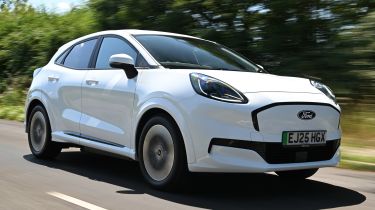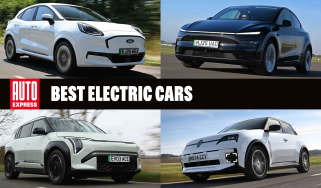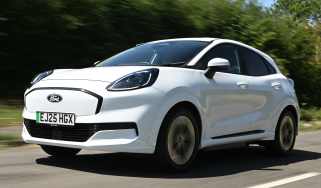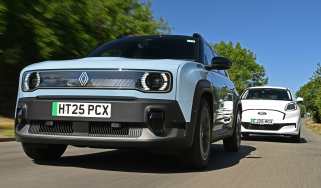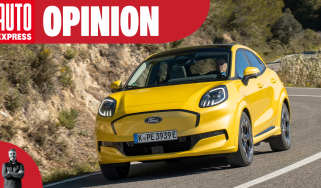Ford Puma Gen-E review
Tight rear passenger space aside, the electric Ford Puma Gen-E is a sound crossover choice

Our opinion on the Ford Puma Gen-E
Switching from petrol to electric drive hasn’t really harmed the Ford Puma driving experience, and the Gen-E is still one of the most entertaining small SUVs to drive. The extra weight of the battery boosts driving comfort, though, while silent running even at motorway speeds means the Puma Gen-E is a relaxing cruiser. A 200-mile real-world range is roughly on a par with rivals, even though the Gen-E has a smaller battery, while there’s been no impact on interior space. That means the Puma is still a little cramped in the back, but the vast boot has been made even more useful with enlarged under-floor storage. Prices are competitive, too, so the Puma Gen-E deserves to be a big seller.
About the Ford Puma Gen-E
Ford’s smallest EV heads down the tried-and-tested route of fitting an electric powertrain to an existing ICE model, but as we found out when we tested the Puma Gen-E against the Renault 4 in the summer, this hasn’t dampened its sense of driving fun. The updates for the 2026 model year are unlikely to change that, while the benefit of the Government’s EV grant helps to make the Puma Gen-E look even more tempting.
There are three variants in the line-up: Select, Premium, and Sound Edition. All models feature LED headlights, a rear view camera with rear parking sensors, lane keep assistance and wireless phone charging, while Premium trim adds a few more luxury features, such as adaptive LED headlights, keyless entry and start, and a powered tailgate. The Sound Edition is a limited-run variant that adds unique alloy wheels and interior seat trim, the winter and advanced driver assistance packs, plus a contrast black roof.
Ford Puma Gen-E prices and latest deals
The Ford Puma Gen-E was the first electric car to meet the criteria required for the full £3,750 discount as part of the Government's Electric Car Grant (ECG) that was announced in July 2025, thanks to part of its electric powertrain being manufactured in the UK.
Used - available now
If you like the idea of owning a Ford Puma Gen-E, then our Buy a Car service is here to help. You can also configure your ideal Ford Puma Gen-E and receive great offers from our network of dealerships, take a look at the best Ford Puma Gen-E leasing deals or choose from a huge selection of top-notch used Ford Puma Gen-E models. Need to sell your car? Be sure to visit our Sell My Car page.
Performance & driving experience
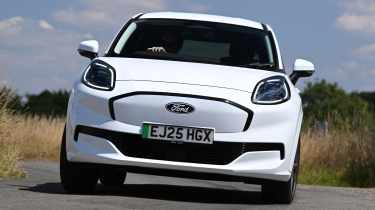
| Pros |
|
| Cons |
|
With extra weight to haul around, the Gen-E can’t match the standard Puma for driving fun, but it’s still an entertaining small SUV, and there’s a bit more comfort in the mix, too.
Ford has done a good job of packaging the electric drivetrain within a bodyshell that was originally designed for combustion engines. Visual clues to the Gen-E include the smoothed-off front bumper and white Puma lettering on the tailgate, while the black housing for the car’s drive battery hangs below the sills – the Gen-E has 129mm of ground clearance as a result, which is 34mm less than the petrol car.
Kerbweight is 1,563kg, which is around 200kg more than an EcoBoost auto model, but is still lighter than most rivals. This helps the Gen-E to feel sprightly and helps with efficiency.
Performance, 0-60mph acceleration and top speed
As with the combustion-engined Puma, the Gen-E is front-wheel drive, but power comes from a 166bhp electric motor with 290Nm of torque. It’s the second most powerful model in the Puma line-up after the ST, although how it delivers its power is very different. The instant torque of the Gen-E’s electric powertrain helps it to sprint off the line cleanly and with zero fuss.
| Model | Power | 0-62mph | Top speed |
| Ford Puma Gen-E | 166bhp | 8.0 seconds | 93mph |
Town driving, visibility and parking
A responsive chassis and quick steering are trademarks of the petrol Puma, and when these are combined with the instant pick-up of the electric powertrain, not to mention the car’s compact dimensions and decent visibility, it means the Gen-E is a perfect choice for city driving. There is a firm edge to the Ford’s ride, but that’s easy to forgive when the trade-off is agile handling.
One major difference between petrol and electric variants is the lack of a handbrake on the Gen-E. Instead, the parking brake is only applied when you select Park via the button on the end of the drive selector on the right-hand side of the steering column. The rest of the time, there’s an auto-hold function that operates as standard. It can be a little jerky to engage or disengage, though, which can make low-speed manoeuvring a bit awkward.
As well as the standard Drive mode, you can move the column shift again to select ‘L’ mode, which increases how quickly the Puma slows when you lift off the throttle. It’s useful in town and means you barely need to touch the brake pedal in stop-start traffic. One-pedal driving is available, but it’s fiddly to access via the touchscreen if you like to change the level of energy recovery when you’re driving.
Country road driving and handling
There’s a bit more weight for the Gen-E to contend with, but overall, it handles as sweetly as the petrol Puma on twisty roads. It’s helped by the fact that the weighty battery is set low in the chassis – you can see its black housing hanging below the sills – so body roll is kept largely in check. There’s lots of grip, too, but when the Puma does reach the limit, its behaviour is neutral with a bias towards understeer.
Sport mode changes the colour of the dials and sharpens the throttle response, while Slippery and Eco settings are also available. The latter dulls the car’s responses and restricts the climate control, too.
In addition to the drive modes, a sound generator has been added to give a sporty edge to the Gen-E’s powertrain. From idle it has hints of the gruff EcoBoost three-cylinder found in the petrol Puma, but it takes on a more synthesised edge at higher speeds.
Motorway driving and long-distance comfort
High-speed refinement takes a step forward with the Gen-E. Wind and road noise are low at the motorway limit, while the EV’s softer suspension helps with ride comfort.
In a lot of small EVs the powertrain can run out of steam at higher speeds, but the Puma still delivers quick reactions. And, of course, the addition of BlueCruise will help to take even more strain out of motorway driving.
We can’t try BlueCruise in the Puma Gen-E until the 2026 model year cars arrive, but I’ve tasted it in a Mustang Mach-E SUV. My route included busy sections of the M6 and M42 around the West Midlands, but the system proved to be effective even when having to deal with narrow lanes through roadworks, offering a smooth drive and sticking to its lane without any jerky steering inputs. At the moment, the system is limited to use on the UK’s motorway network, but it is a welcome addition to the roster of safety kit on the Puma Gen-E. – Dean Gibson, senior test editor
Range, charging & running costs

| Pros |
|
| Cons |
|
Discounts on already competitive prices help the Puma Gen-E to look even more attractive, while excellent efficiency makes best use of the battery capacity that’s available.
Electric range, battery life and charge time
The Puma Gen-E only has a modest 53kWh battery with a usable capacity of 43kWh, although this increases to 47kWh for 2026. Battery size is on a par with the Renault 4 and rival small SUVs from Stellantis, but the Ford has efficiency on its side. We’ve tested the 2025 car in hot and chilly conditions, but on all occasions it’s had the measure of its rivals.
At the height of summer, a return of 4.7 miles per kWh was well ahead of the Renault 4 (4.0mi/kWh), while in colder weather it only decreased to 4.4mi/kWh when the Suzuki e Vitara (admittedly with less efficient four-wheel drive) could only manage 2.8mi/kWh. The Puma’s official range of 233 miles will increase to 248 miles for 2026 model-year cars, and we fully expect the Puma to equal its closest rivals for overall range, despite many of them having larger battery packs at their disposal. It’s worth noting that, unlike with the Explorer and Capri, there’s no option to add an energy efficient heat pump to help boost cold-weather efficiency.
One disappointing aspect of the Puma Gen-E that won’t change with the 2026 model year is charging speeds. There’s a maximum rate of 100kW on offer, which is behind the best in the class, although it does mean the Puma’s battery can be charged from 10-80 per cent capacity in 23 minutes when plugged into a powerful enough DC source.
| Model | Battery size | Range | Insurance group |
| Puma Gen-E | 43kWh | 233 miles | 18 |
| Puma Gen-E | 47kWh | 248 miles | 18 |
Insurance groups
The Puma’s sheer numbers mean that parts availability is good, although the Gen-E is in groups 18 and 19, with only the high-performance ST model sitting higher. That’s still a pretty good group rating, though; electric versions of the Peugeot 2008 and Vauxhall Mokka sit in group 22 and higher, while the Renault 4 is in groups 27 and 28.
Tax
Low list prices mean that the Puma Gen-E will be a cheap company car to run, with lower-rate taxpayers facing annual bills of less than £200 for either model. But rivals such as the Renault 4 are cheaper still. Annual road tax for the Gen-E is the same as that for the standard Puma because EVs now pay it at the same rate as a combustion-engined car.
Depreciation
The Puma is a big seller, so its residuals are only average, while it appears that the novelty of the Gen-E has worn off since its launch, and the Government grant discount is likely to have had an impact, too. Although it had residuals of up to 50 per cent when it was launched in the summer, it’s now dropped into the 40-42 per cent range, around seven per cent behind the petrol cars. For reference, the hot Puma ST still retains 54 per cent of its list price after three years.
Interior, design & technology
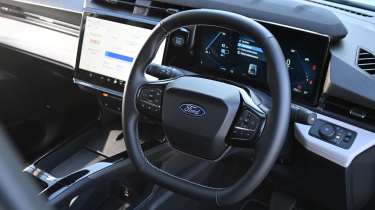
| Pros |
|
| Cons |
|
With the demise of the Ford Fiesta, it’s down to the Puma to fly the flag for Ford’s small cars, and as a result, it has become a common sight on UK roads. That’s no bad thing, because its compact dimensions and tight proportions mean it looks smart.
The clues are there to help separate the Gen-E from petrol versions of the Puma. The Gen-E adds a smoother nose up front and machined alloy wheels that look as if they should boost efficiency, but overall, the look remains unchanged.
Interior and dashboard design
Packaging an electric drivetrain into a bodyshell originally designed for combustion engines is tricky, but Ford has pulled it off. The biggest visual clues to the Gen-E include the body-coloured panel where the grille sits on the petrol Puma, a machined finish for the alloy wheels and white lettering on the tailgate. A less subtle indicator is the Gen-E’s reduced ground clearance – at 129mm it sits 34mm closer to the road than the petrol car.
The biggest update inside is to the centre console, which features a split-level design finished in piano-black plastic. The drive selector is on the steering column; like Ford’s other EVs, the Gen-E has its indicators and wipers on a stalk to the left of the wheel.
Materials and build quality
The Gen-E feels just as well built as the petrol Puma, with harder plastics lower down in the cabin that feel sturdy, plus leather-effect trim on the dashboard for a more premium feel. We do wonder how well the shiny plastic centre console trim will stand up to knocks and scratches, though.
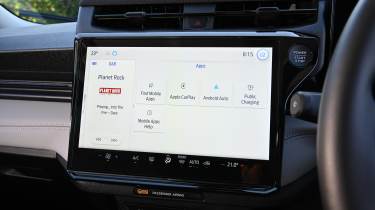
Infotainment, sat-nav and stereo
Sitting on top of the dash is a piece of fabric-covered trim which is actually a sound bar, a design feature that also appears in the larger Explorer and Capri EVs. Top-spec Premium models, and the limited-run Sound Edition, are upgraded with a B&O system for additional audio pleasure.
The climate controls are on permanent display across the bottom of the touchscreen, so they’re relatively easy to use when you’re moving, but the temperature selection is a bit too fiddly. You press it once for a temperature bar to appear, then you need to use the screen a second time to adjust it; we’d be happier if it was a single press for convenience. If you want more detailed control of the cabin climate, there’s a menu to navigate to, but the three-stage Auto setting is pretty effective as it is.
The large 12-inch display in the Puma has sharp graphics and quick responses, so it's pleasant enough to use. At start-up the home screen is split into three, or you can select one function to take up the whole screen. However, a wide side bar allows you to flip between functions, even if you’re using your smartphone apps.
A button in the top-right corner gets you back to the home page, although the size of the display means that a section of the screen is obscured by the steering wheel.
"Ford isn’t shy with rolling out special editions, and new on the list is the Puma Gen-E Sound Edition. This provides enhancements to the cabin audio, while exterior upgrades include grey 18-inch alloys, an exclusive Metropolis White option, plus a black roof and door mirror caps." – Dean Gibson, senior test editor
Boot space & practicality
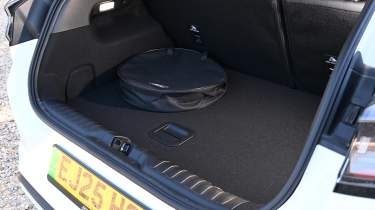
| Pros |
|
| Cons |
|
The Puma packs plenty of practicality into its compact dimensions, even if the rear seats are a bit too small for family use.
Dimensions and size
The Puma Gen-E has exactly the same dimensions as the petrol model, so that means it’s compact, but clever packaging means there’s plenty of usable space within its length.
| Dimensions comparison | |||
|---|---|---|---|
| Model | Ford Puma Gen-E | Renault 4 E-Tech | Suzuki e Vitara |
| Length | 4,313mm | 4,144mm | 4,275mm |
| Width | 1,805mm | 1,808mm | 1,800mm |
| Height | 1,555mm | 1,572mm | 1,640mm |
| Wheelbase | 2,588mm | 2,624mm | 2,700mm |
| Boot space | 556-1,283 litres | 420-1,405 litres | 238-562 litres (to window line) |
Seats & passenger space
There’s a snug feeling to the Gen-E’s cabin, courtesy of the high-set centre console, but a wide range of wheel and seat adjustment means that it doesn’t feel cramped.
The console has trinket trays on top and underneath, while there’s a wireless phone charging pad below the dash and USB sockets beneath. Most control functions are operated via the touchscreen – only a volume knob and switches for the hazard lights, drive modes and windscreen demister remain. Storage is fine, with a reasonable centre armrest bin, while the door bins are a decent size, but awkwardly shaped.
Choosing the Gen-E over the petrol Puma doesn’t demand compromise in terms of interior space, but the car itself is a little snug in the back when compared with some rival small SUVs. There’s not as much head or legroom as you’ll find in many rivals, and three-abreast seating will be especially tight – the rear bench is so narrow that there’s no fold-out armrest, and the centre seat is more of a perch. The small rear windows add to the claustrophobic feel, while hard plastics are the order of the day. Luxuries are few and far between, with just USB sockets on offer.
Boot space
To make up for the shortage of passenger space, the Puma has a vast boot, and it’s even roomier in Gen-E guise. The main space is fine, but the surprise is under the boot floor, where the GigaBox resides. The petrol Puma features a MegaBox, with a plastic recess and drain plug, but the Gen-E’s is even bigger with an extra 65 litres of capacity to create a 145-litre space. But the load lip is quite high, while the flimsy fabric load cover feels cheap and easy to break.
Another interesting feature is that the Puma has storage under the bonnet - that’s almost unheard of for an EV that’s been converted from a petrol model. Ford quotes a capacity of 43 litres, but the shape of the area means it’s a bit awkward to get items in - a charging cable will barely fit.
Ford is very keen to get buyers behind the wheel of the Puma Gen-E. As well as including five years of complimentary servicing, roadside assistance and online services with each car, not to mention the full Government EV Grant qualification, the firm is also offering the Ford Power Promise (until the end of 2025). This is available to any buyer of a Ford EV, and means you can arrange for either a free home wallbox charger with standard installation or 10,000 miles of free electricity, courtesy of provider Octopus Energy. - Dean Gibson, Senior test editor
Reliability & safety
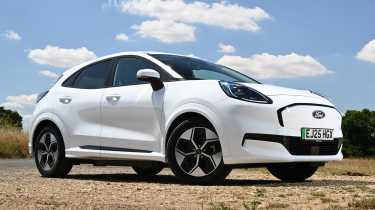
| Pros |
|
| Cons |
|
Euro NCAP’s four-star score for the petrol Puma also applies to the Gen-E, while the optional Advanced Driver Assistance Pack (£950) must be added if you want 360-degree cameras, front parking sensors, adaptive cruise control and blind-spot detection.
While the electric version wasn’t a part of the latest 2025 Driver Power customer satisfaction survey, the regular Puma came 47th out of 50 cars in the best cars to own list. Owners enjoyed the look of their cars but weren’t impressed by the interior finish, reliability, visibility from the driver’s seat, or the level of service they received from their Ford dealer. The electric version should hopefully improve upon this because EVs are generally simpler to maintain, and the Puma Gen-E has longer 24-month service intervals, so you don’t need to visit the dealer quite as often.
| Euro NCAP safety ratings | |
| Euro NCAP safety rating | Four stars (2022) |
| Adult occupant protection | 75 per cent |
| Child occupant protection | 84 per cent |
| Vulnerable road user protection | 70 per cent |
| Safety assist | 69 per cent |
Buying and owning
Best buy: Ford Puma Gen-E Select
While it might be tempting to go for the range-topping Premium trim, we’d stick with the entry-level Select model. It has a marginally longer range thanks to its smaller 17-inch wheels, and it keeps the price competitive with its rivals. The reasonably priced Winter Pack is a worthwhile addition for £350 to get heated seats and a heated steering wheel, and if you really want some additional driver assistance technology, you can add the Driving Assistance Pack for £950, and still save yourself some money compared with the top-of-the-range trim. Even better is that if you order a new Puma Gen-E today, you’ll be getting a 2026 model with the longer range and extra kit.
Ford Puma Gen-E alternatives
A chief rival for the Puma Gen-E is the Renault 4 - it’s similarly priced, and when we tested the pair together, they were very closely matched for performance, range and equipment. What puts the R4 ahead, though, is the additional interior space for back-seat passengers.
Elsewhere, the small SUV sector is quite busy, with the Stellantis group offering a number of opponents. These include the Vauxhall Mokka Electric, Peugeot e-2008, Jeep Avenger and Alfa Romeo Junior. Or there’s the MINI Aceman as a sporty alternative, the Volvo EX30 and Hyundai Kona Electric or Kia EV3.
Deals on the Ford Puma Gen-E and alternatives
Frequently Asked Questions
In terms of warranty cover, Ford’s three-year/60,000-mile package is pretty average these days, although you can pay to extend cover up to five years and 100,000 miles. The Gen-E’s battery is covered for eight years or 100,000 miles.

